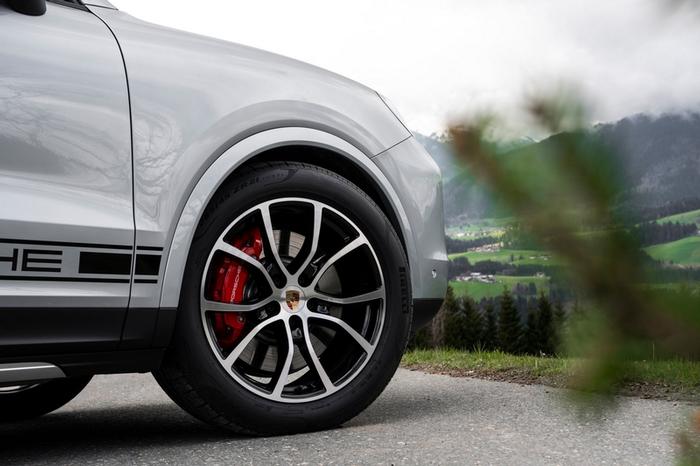Pros: great handling, impeccable refinement, lovely interior
Cons: expensive to buy and run
Porsche Cayenne S Design
Porsche’s once-contentious Cayenne SUV has been around for more than 20 years now, so we’re almost familiar with its overall shape. Having said that, a round of visual updates for the third-generation model do enough to tidy the aesthetics and keep it fresh – most cars would be ending their life cycle after seven years, not having a midlife update. The main changes are at the front, where all the bonnet, wings and headlights are new, while round the back a full-width light strip has been drafted into service. One of the more significant alterations is that, on the SUV-shaped models (i.e. not the Cayenne Coupe), the rear number plate has been moved from its previous location on the tailgate down into the bumper on the 2024 model year Cayennes.
Porsche Cayenne S Interior
The all-electric Taycan has inspired the rest of the Porsche range, as the Cayenne is one of the latest models to get a cabin inspired by the EV. That means there’s now a beautiful, and configurable, 12.6-inch instrument cluster behind the Cayenne’s steering wheel, while the gear selector has moved from the centre console to a position up on the dashboard, next to the steering wheel. The optional 10.9-inch Passenger Display touchscreen also comes into the reckoning, so with it equipped there will be three large digital screens arrayed across the entire width of the SUV’s fascia.
Thankfully, this is not all technology for technology’s sake, because everything works intuitively and looks glorious. Beyond that, material quality in the Cayenne is exemplary, while space for a quartet of adult passengers is generous front and rear, albeit the central seating position in the back of the car is hampered by a transmission tunnel hump in the footwell. On the plus side, this S model has a colossal 772-litre boot in SUV format.
Porsche Cayenne S Performance & Drive
Much of the facelifted Cayenne’s powertrain range has been changed, with the overall mix swinging heavily towards a plug-in hybrid (PHEV) bias – in the Cayenne SUV line-up, rather than the Coupe, fully three-out-of-five models are PHEVS; for the Coupe, that ratio rises to four-in-six, with the addition of a body-specific, ultra-high-performance Turbo E-Hybrid with GT Package range-topper.
The most appealing update, though, is reserved for this model, the Cayenne S. Where it previously had a 440hp 2.9-litre twin-turbo V6, it now sports a 4.0-litre biturbo V8 developing 474hp. It’s the first time the regular ‘S’-badged Cayenne model has had a V8 engine since 2014, when the second-gen model was facelifted and the S went the other way, from a V8 to a V6 in a process known as downsizing.
The return of the V8 here is most welcome – mainly because the facelifted S is now the only petrol model with this muscular 4.0-litre engine fitted. It has been tuned to be more subdued and discreet here, as the S isn’t an out-and-out driver-focused model, but the combination of this rich-sounding, effortlessly torque 4.0-litre unit and the Cayenne’s sublime chassis settings results in what is arguably the best big, luxury SUV on sale right now. Whether you want serene ride comfort and an almost-silent passenger compartment when travelling on the motorway, easy-to-modulate controls and linear throttle response at town speeds, or exceptional body control and grip on a quieter back road, the Cayenne S can serve it all up. In spades.
Perhaps the only drawback of the bigger engine with more cylinders is fuel consumption. Reckon on a mixed average of about 13.9 litres/100km, with a best hovering near 10.7 litres/100km on a steady motorway run.
Porsche Cayenne S Pricing
Aside from the steep fuel costs, buying a Porsche Cayenne S is not cheap. While it comes with a wealth of desirable kit, and obviously its ingrained dynamic talents, our CO2-based taxation (Cayenne S: 282-303g/km) means the VRT pushes the asking price of the V8-powered SUV perilously close to the flagship Turbo E-Hybrid. So, while you can get into a Cayenne E-Hybrid from €101,599, with the new 519hp Cayenne S E-Hybrid also offered for €110,951, having the non-hybrid Cayenne S sees the windscreen sticker leap to €163,410; that Turbo E-Hybrid, meanwhile, is only a little more at €165,151. Also, your motor tax bill in the Cayenne S will be €2,400 each year. Ouch.
Carzone Verdict
If it weren’t for the exorbitant list price of the updated Porsche Cayenne S, caused by its high CO2 emissions, we’d be arguing for this model as the pick of the new range. It does everything brilliantly, and nothing notably wrong at all. Of course, any six-figure machine is expensive, so it’s not as if we could call the entry-point Cayenne E-Hybrid a bargain, but there are significant premiums to pay throughout the ownership period if you want this V8 model instead. Yet, if you can afford it, this is the best new Cayenne of the lot, as it’s sublime in most key regards.


